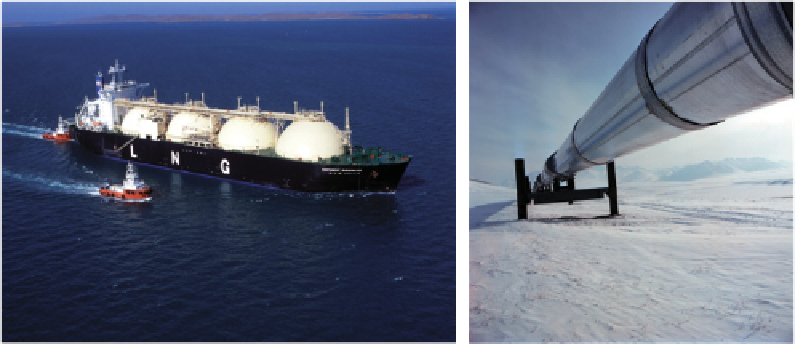Environmental Engineering Reference
In-Depth Information
13.1.2 Storage and Transport of Hydrogen
Once hydrogen has been produced, it has to be stored and transported to the con-
sumer. In principle, we are familiar with the storage and transport of combustible
gases from the use of natural gas. Hydrogen is an extremely lightweight gas with
very minimal density but has a relatively high calorifi c value. Compared to natural
gas, hydrogen with the same energy content requires much larger storage volumes
although the stored hydrogen is much lighter.
Hydrogen can either be compressed, stored under high pressure or liquefi ed in order
to reduce the necessary storage volumes. Under normal pressure hydrogen con-
denses but not until it reaches extremely low temperatures of minus 253 °C. A high
amount of energy is needed to achieve such low temperatures. Twenty to 40% of
the energy stored in the hydrogen is used to liquefy it. Liquid hydrogen is abbrevi-
ated as LH2.
In principle, the same technologies used in the natural gas sector can be used for
the liquidization, transport and storage of hydrogen. Hydrogen can be transported
either in pipelines or in special tankers and freighters. Whereas pipelines usually
transport the gaseous form, tankers are preferred for liquid hydrogen to reduce the
volume. In contrast to hydrogen, natural gas already becomes liquid at minus 162 °C
and is abbreviated as LNG (liquid natural gas) (Figure 13.4).
Figure 13.4
Experience from the natural gas sector can be used for storing and transporting hydrogen.
Left: Liquid gas tanker. Right: Pipeline.
Source: BP, www.bp.com.
Compressed gas or liquid gas tanks are used to store small quantities. Another
disadvantage of hydrogen is the very small atomic portion, which makes it extremely
volatile. Large quantities of hydrogen can be lost if is stored in metal tanks for long
periods of time, because it diffuses through the storage walls. Underground storage
is recommended for large quantities of hydrogen, whereby it is compressed at high
pressure into underground storage shafts and extracted when needed.

